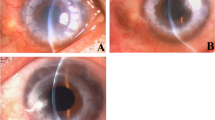Abstract
This study was conducted to characterize ultrastructural damage to human corneas cryopreserved by a standard protocol. The materials used were seven human corneas that were unsuitable for transplantation due to the presence of positive bacteriological cultures; they were cryopreserved according the standard procedure. After freezing and thawing, samples were obtained for scanning and transmission electron microscopy studies. Marked damage was observed in keratocytes with signs of apoptotic cellular injury. However our observations have shown that apoptosis contribute less significantly than necrosis to cellular death in keratocytes of human corneas and although the control of apoptosis is clearly desirable, in order to improve the success of cryopreserved corneas for transplant, we need to continue our investigation to reduce the effects of the necrotic process.
Similar content being viewed by others
References
Baust J. M. 2002. Molecular mechanisms of cellular demise associated with cryopreservation failure. Cell. Preserv. Technol. 1: 17–31.
Canals M., Garcý´a J., Potau J. M., Dalmeses C., Costa-Vila J. and Miralles A. 2000. Optimization of a method for the cryopreservation of rabbit corneas: attempted application to human corneas. Cell. Tissue Bank. 1: 271–278.
Canals M., Costa-Vila J., Potau J. M., Merindano M. D. and Ruano D. 1999. Morphological study of cryopreserved hu-man corneal endothelium. Cell. Tissues Organs 164: 37–45.
Hilbert S. L., Luna R. E., Zhang J., Wang Y., Hopkins R. A., Yu Z. X. and Ferrans V. J. 1999. Allograft heart valves: the role of apoptosis-mediated cell loss. J. Thorac. Cardiovasc. Surg. 117: 454–462.
Routledge C. and Armitage W. J. 2003. Cryopreservation of cornea: a low cooling rate improves functional survival of endothelium after freezing and thawing. Cryobiology 46: 277–283.
Villalba R., Peña J., Luque E. and Go´mez-Villagra´n J. L. 2001. Characterization of ultrastructural damage of valves cryopreserved under standard conditions. Cryobiology 43: 81–84.
Wilhelmus K. R., Stuling R. D., Sugar J. and Khan M. M. 1995. Primary corneal graft failure. A national reporting system. Arch. Ophthalmol. 113: 1497–1502.
Wusteman M. C., Boylan S. and Pegg D. E. 1997. Cryopreser-vation of rabbit corneas in dimethyl sulfoxide. Invest. Oph-talmol. Vis. Sci. 38: 1934–1943.
Author information
Authors and Affiliations
Rights and permissions
About this article
Cite this article
Villalba, R., Peña, J., Luque, E. et al. Keratocyte injury in human corneas cryopreserved under standard conditions. Cell Tissue Banking 5, 201–204 (2004). https://doi.org/10.1007/s10561-004-1091-2
Issue Date:
DOI: https://doi.org/10.1007/s10561-004-1091-2




